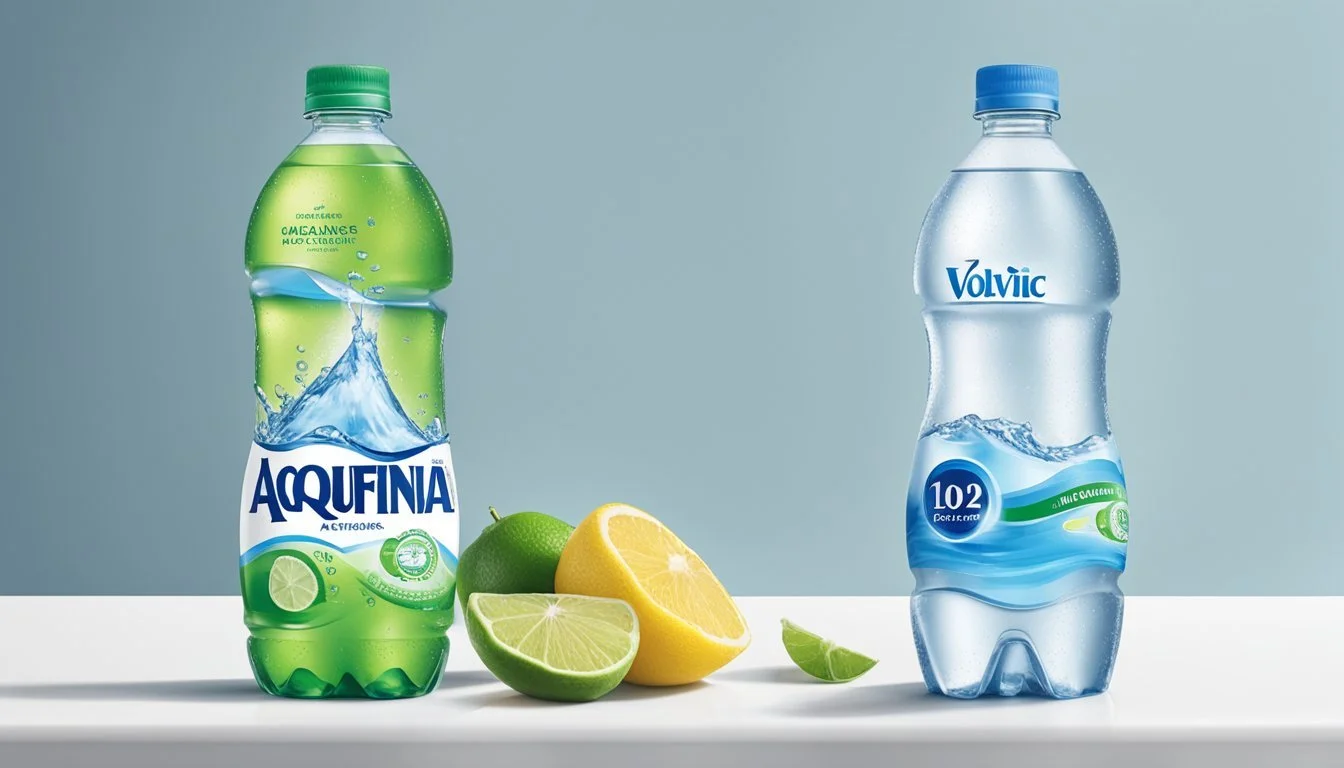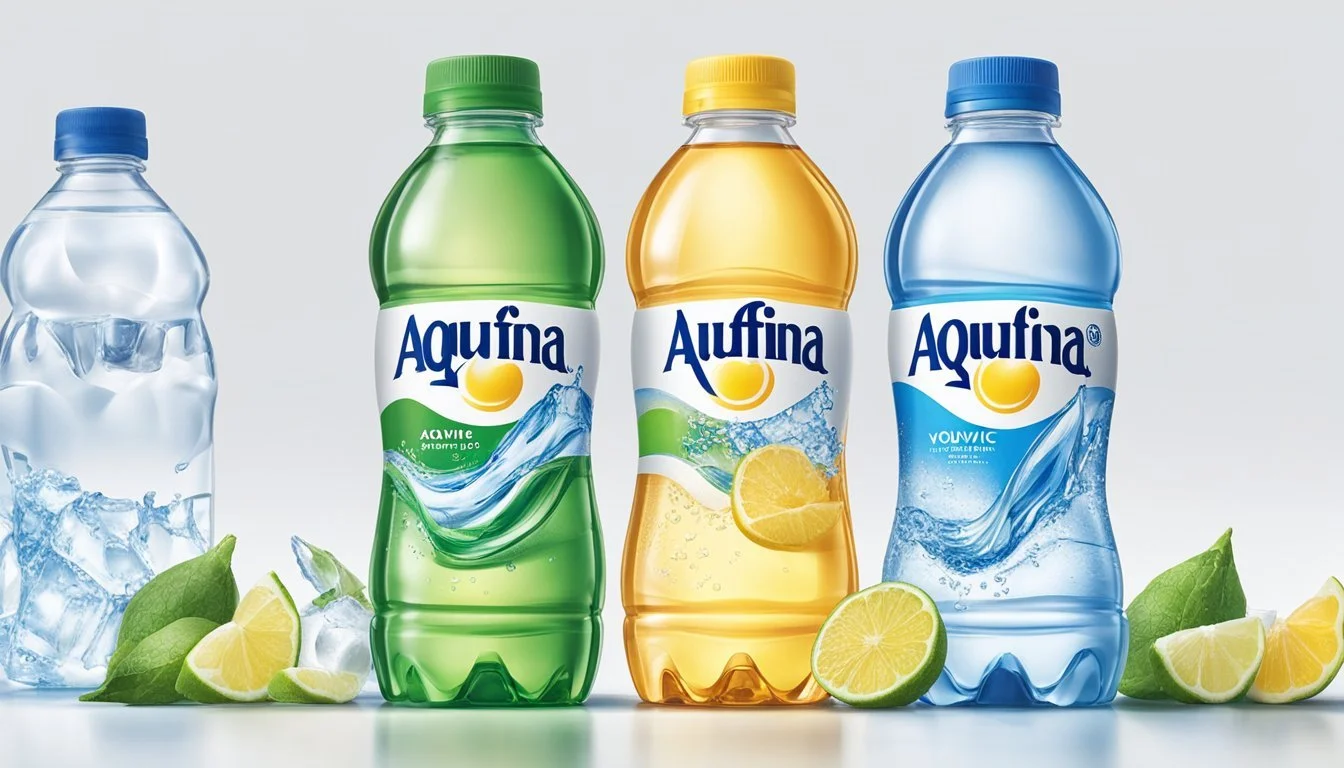Aquafina vs. Volvic
A Comprehensive Comparison of Bottled Waters
When it comes to bottled water, consumers are often faced with a multitude of options, each boasting purity, taste, and health benefits. Two prominent brands in the market are Aquafina and Volvic. Aquafina, sourced from municipal tap water and purified through a rigorous, seven-step process called HydRO-7, is a widely available product of PepsiCo. It promises to offer crisp, clean water by removing substances like chlorides, salts, and other volatile organic compounds.
Volvic, on the other hand, is a brand that sources its water from the Auvergne region in France, specifically from the Chaîne des Puys volcanic complex. The filtration process through volcanic rock not only enriches the water with minerals but also gives it a distinctive taste profile. Unlike Aquafina, Volvic's hydration offering includes naturally occurring electrolytes and trace elements, which presents a different appeal to health-conscious consumers.
In evaluating which bottled water is better, one must consider several factors, such as the purification process, the source of the water, the mineral content, taste, packaging, brand values, and environmental impact. Both Aquafina and Volvic provide safe, clean drinking water, yet they cater to different preferences and values, ultimately reflecting in the choice consumers make.
Understanding Bottled Water
In determining whether Aquafina or Volvic is superior, it is critical to consider the distinctions in bottled water types and the regulatory framework that governs them.
Types of Bottled Water
Bottled water can be broadly categorized based on its source and treatment methods. Here are the primary types:
Spring Water: Sourced from natural springs, this water must flow naturally to the Earth's surface or be obtained via a borehole tapping the underground formation feeding the spring. Spring water retains the minerals that it acquires from the soil, though it is often treated for safety.
Purified Water: This category applies to water that originates from any source but has been treated to remove chemicals and pathogens. Purification methods, such as reverse osmosis, distillation, or deionization, significantly reduce dissolved substances, including minerals and electrolytes.
Mineral Water: Rich in various minerals such as calcium, magnesium, and potassium, mineral water comes from geologically and physically protected underground water sources. Unlike purified water, mineral water is required to have consistent mineral content with minimal processing.
Alkaline Water: This is water that has a higher pH level than regular drinking water and often contains added minerals to increase its alkalinity.
Electrolytes Enhanced Water: Often sold under various water brands, this is water that has electrolytes added for taste and to replenish the body's minerals.
Regulation and Safety Standards
Bottled water is subject to stringent regulatory standards to ensure safety and quality. In the United States, for instance, the Environmental Protection Agency (EPA) regulates tap water, while the Food and Drug Administration (FDA) oversees bottled water. They ensure the water meets minimum safety standards and is appropriately labeled.
EPA: Sets standards and regulations for municipal water supplies, focusing on over 90 contaminants.
FDA: Implements standards for bottled water, which must comply with limits for microorganisms, chemicals, and radiological contaminants.
Manufacturers must frequently test their waters and adhere to specific labeling and quality protocols. The International Bottled Water Association (IBWA) also provides guidance and best practices in the industry, echoing FDA standards and sometimes implementing more stringent ones.
Consumers typically rely on these regulations to trust that the bottled water they purchase, whether a widely known brand or a niche product, is safe to drink and meets the advertised qualities, such as being rich in minerals or electrolytes.
Brand Profiles
In the bottled water industry, brand heritage, source, and marketing significantly influence consumer preference. The following profiles of Aquafina and Volvic reveal distinct approaches to water production and branding, while also acknowledging the presence of other notable brands in the market.
Aquafina
Aquafina is a brand of purified water that was first launched in Wichita, Kansas, in 1994 by PepsiCo. Aquafina's purification process includes hydro-7 filtration, which consists of several stages including reverse osmosis, ozone sterilization, and charcoal filtration. Its purification system is designed to remove substances other than hydrogen and oxygen to ensure purity. Aquafina positions itself as a clean, and crisp water, aligning with its corporate branding.
Volvic
Volvic is a brand of mineral water sourced from the Volcanic Eifel region in Auvergne, France. Bottled at its source since 1958, Volvic water filters through six layers of volcanic rock which naturally enriches it with minerals and electrolytes. The brand stands out for its mineral-rich composition and natural filtering process. Owned by the Danone Group, Volvic emphasizes its natural origin and the balance of its mineral content.
Other Popular Brands
Dasani: Owned by Coca-Cola, Dasani water is filtered and has added minerals for taste.
Evian: Sourced from the French Alps, Evian is known for its mineral content and taste.
Fiji: Originating from the islands of Fiji, this water is filtered through volcanic rock for its unique mineral profile.
Voss: Presented in distinctive cylindrical bottles, Voss water hails from Norway and is also known for its purity.
Poland Spring: A popular spring water brand in the United States, sourced from multiple springs in Maine.
Smartwater: Another Coca-Cola brand, Smartwater is vapor-distilled with electrolytes added for flavor.
Nestlé Pure Life: Produced by Nestlé Waters, this brand offers purified water that's widely available globally.
Essentia: Essentia Water is ionized alkaline water with a pH of 9.5 or higher, marketed for its smooth taste and hydrating properties.
These profiles reflect a diverse range of sources and treatment processes which lead to varying taste profiles and mineral contents, creating a unique proposition for consumers. Each brand has carved out its niche, appealing to differing consumer preferences and occasions for use.
Source and Filtration Process
When considering bottled water, the purity and quality often come down to the source and the methods used to filter the water. Different brands employ unique processes ensuring their water achieves a certain standard.
Aquafina's Purification
Aquafina utilizes purified water that originates from municipal sources. The brand’s purification process, known as HydRO-7, is designed to remove microscopic particles and other contaminants. This filtration process involves multiple stages:
Sedimentation: Removes large particles
Carbon Filtration: Targets organic compounds and chlorine
Reverse Osmosis: Extracts dissolved solids, such as metals
Ultraviolet Light: Ensures disinfection
Each step is tailored to ensure the resulting product is of consistent purity and taste.
Volvic's Volcanic Filtration
Volvic's water is naturally filtered through volcanic rock which imbues it with minerals. The water is sourced from an aquifer at the site of an ancient volcano in the Auvergne region of France. This natural approach to filtration includes:
Micro-porous Volcanic Rock: Traps impurities while adding minerals
Natural Path: Water travels through underground layers, ensuring gradual purification
The process inherently leverages the unique geological properties of volcanic formations.
Comparative Filtration Techniques
Aquafina and Volvic's filtration methods contrast significantly. Aquafina emphasizes a technologically advanced purification system, rigorously controlling the quality of the water by treating it after it is sourced. In contrast, Volvic benefits from a naturally occurring filtration process where the volcanic terrain does much of the work, with additional steps likely included by the company to meet standards. Both brands, through their respective processes, aim to offer high-quality water, although the end products have different characteristics and mineral compositions because of the distinct sources and methods used.
Nutritional Content and Health Benefits
When considering bottled water like Aquafina and Volvic, their differences in mineral content, influence on hydration and electrolyte balance, as well as pH and acidity levels are key factors in assessing their health benefits.
Mineral Content
Aquafina is demineralized water, meaning it has undergone processes like reverse osmosis that strip it of most minerals. In contrast, Volvic is a naturally sourced mineral water from volcanic regions in France, providing essential minerals such as calcium and magnesium. These minerals are not only necessary for maintaining bone health but also play a role in various metabolic functions.
Hydration and Electrolytes
Both Aquafina and Volvic effectively hydrate, albeit through different mineral contents. While hydration is fundamentally about replenishing bodily fluids, electrolytes like sodium and potassium, which are more prevalent in Volvic, are crucial for maintaining the body's proper balance of fluids. They aid in functions such as muscle contraction and nerve signaling.
pH and Acidity Levels
The pH level of water is a measure of its acidity or basicity. Aquafina typically has a pH close to neutral, around 7, which is ideal for matching the body's natural pH. Volvic also has a fairly neutral pH, typically slightly more alkaline than Aquafina, which may be beneficial in balancing the overall dietary intake of acid and alkaline foods and beverages.
Taste and Aesthetic Comparison
Exploring Aquafina and Volvic from a sensory perspective, the following subsections compare their water taste and consumers' aesthetic preferences using direct testing observations and market feedback.
Water Taste Testing
During blind taste tests, participants often describe Aquafina as pure and crisp, resulting from its rigorous purification process, which includes reverse osmosis. However, this process strips it of many minerals, potentially impacting the natural taste some consumers prefer. Conversely, Volvic, known for its volcanic filtration system, is often noted for its distinctive, refreshing taste that reflects its unique mineral composition.
Aquafina: Pure, crisp taste; some may find it lacks depth due to demineralization.
Volvic: Distinctive mineral taste; often described as more refreshing and natural.
Consumer Preferences
Individual preferences for bottled water can be subjective, influenced by factors beyond the taste test bench. Aesthetically, Aquafina's packaging is sleek, aligning with its modern branding, while Volvic offers a more earth-tone design that resonates with its natural volcanic branding.
Aquafina's Aesthetic:
Packaging: Sleek and modern.
Branding: Focuses on purity.
Volvic's Aesthetic:
Packaging: Earthy and natural.
Branding: Emphasizes volcanic origin.
Choices in bottled water are frequently tied to personal taste preferences and perceptions of the brand's image rather than blind assessments of taste alone.
Environmental Impact and Sustainability
When evaluating bottled water brands such as Aquafina and Volvic, understanding their environmental impact and sustainability practices is essential. Both brands have taken steps toward sustainability but differ in their bottling processes and packaging materials.
Bottling Process
Aquafina, owned by PepsiCo, utilizes a purification process that includes reverse osmosis and other filtration methods. They focus on efficiency to minimize water waste. Volvic, sourced from volcanic springs in France, claims a unique natural filtration process that takes years to complete, which also emphasizes preservation of the natural environment where it's sourced.
Packaging Materials
Both brands have implemented measures to reduce the environmental footprint of their packaging. Aquafina bottles are made of plastic containing BPA, which raises health and environmental concerns, whereas Volvic bottles are BPA-free.
Aquafina:
Plastic bottles: Contain BPA.
Recycling initiative: Active in recycling programs.
Volvic:
Plastic bottles: BPA-free.
Recycled materials: Uses recycled PET.
Additionally, alternate packaging solutions like boxed water, which claim to be more sustainable, are not utilized by either brand.
Economic Factors
The choice between Aquafina and Volvic water is influenced not only by personal taste but also by economic considerations. Consumers weigh both cost and brand value to determine which offers the better deal.
Cost Comparison
Aquafina, produced by PepsiCo, is often seen as an affordable option, widely available in various retail settings. In terms of pricing, Aquafina's extensive distribution network helps in keeping costs competitive, making it a popular choice for consumers seeking value.
Quantity Aquafina (Approx. price) Volvic (Approx. price) 500 mL $1 $1.5 1 Liter $2 $2.5 1.5 Liter $2.5 $3.5
Volvic, sourced from France and known for its quality and unique volcanic filtration, tends to be more expensive. This premium pricing reflects the brand's positioning as a high-end bottled water.
Brand Value
Aquafina has leveraged PepsiCo's global reach to establish itself firmly in the market, enhancing its value through widespread recognition and consumer trust. It is one of the more popular brands in the United States, contributing to its strong brand value.
Volvic is recognized for its unique origin and quality. It's a product of Danone, a multinational corporation with a significant presence in the bottled water industry. While Volvic may not match Aquafina's popularity in every market, its emphasis on natural purity from the Auvergne volcanoes in France appeals to a segment of consumers who prioritize product backstory and quality in their purchasing decisions.
Consumer Insights
When assessing the better bottled water between Aquafina and Volvic, consumers weigh factors like quality, taste, and brand reputation. They're influenced by market trends and often refer to rankings when making their choice.
Market Trends and Preferences
In the bottled water industry, consumer preferences have shifted toward high-quality water sources with an emphasis on taste and purity. Market trends indicate that people are becoming more health-conscious and environmentally aware. Aquafina and Volvic are two bottled water brands that consumers frequently encounter. Aquafina, sourced from municipal reserves, undergoes a rigorous purification process that includes reverse osmosis. Volvic, on the other hand, is naturally filtered through volcanic rock, which enhances its mineral content and taste, making it a popular choice for consumers seeking mineral-rich bottled water.
Bottled Water Rankings
When it comes to rankings, consumers often look at lists that categorize bottled waters from worst to best. There isn't a universally accepted ranking system for bottled water; however, certain factors such as taste, source, and contaminant levels are commonly used metrics. Brands that are consistently favored in taste tests and found to be low in contaminants are often deemed high-quality.
Aquafina might be seen as less desirable by some consumers who prioritize natural spring or mineral waters over purified municipal water. Volvic might be favored for its volcanic filtration process which is perceived to provide a unique and beneficial mineral blend. The reputation of these brands within popular rankings can significantly sway consumer preference, as people tend to trust brands that are ranked favorably by credible sources.
Conclusion
When comparing Aquafina and Volvic, consumers must consider purity levels, taste, packaging, and environmental impact.
Aquafina, produced by PepsiCo, is known for its rigorous purification process, which includes reverse osmosis and other filtering methods. It often boasts a clean, crisp taste but lacks natural minerals due to its purification process. The packaging is primarily plastic, which raises concerns over environmental sustainability.
Volvic, sourced from volcanoes in France, provides natural mineral content that can contribute to the overall taste and may offer health benefits. The natural filtration process of volcanic rock gives it a distinctive flavor profile. However, the environmental impact of international shipping and plastic bottles should not be overlooked.
In terms of taste, Volvic might be preferred by those who enjoy a more natural mineral taste, whereas Aquafina may be favored by those seeking a pure, unadulterated flavor. Consumers should note that taste is subjective and can vary based on individual preference.
Environmental considerations are increasingly important. Both brands typically use plastic bottles, contributing to environmental concerns, though recycling and eco-friendlier practices are being adopted to some extent.
Ultimately, the choice between Aquafina and Volvic depends on personal preference aligned with taste and environmental values. Consumers are advised to weigh the factors of mineral content, purification methods, taste, and environmental impacts before making a decision.






